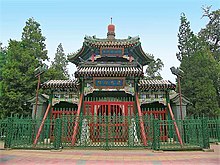Niujie Mosque
The Niujie Mosque ( Chinese 牛街 礼拜寺 , Pinyin Niújiē lǐbàisì , English Niujie Mosque / Ox Street Mosque - "Mosque in Rindergasse"), which is also referred to in Chinese as Niujie Qingzhensi (牛街 清真寺) and Mingsi (明 寺) , is the mosque in Beijing's Xuanwu district on 88 Niujie Street ("Cattle Street"). It is the oldest mosque in the city.
General
The mosque was initially built as a relatively small complex during the Kite rule (916-1125) or, according to the Chinese era, in the second year of the Zhidao reign of the Song Emperor Taizong (996) and in the Mongol , Ming and Manchu periods expanded. After the expansion under the Qing Emperor Kangxi , it is now also the largest mosque in Beijing, which can accommodate over a thousand people.
At first glance, the mosque is reminiscent of a Chinese temple, but it represents a mixture that unites Chinese and Arabic architectural styles. The mosque has a floor area of almost 6000 square meters and consists of three courtyards one behind the other with rooms on all four sides.
The building called Wangyuelou (moon observation building) was used to determine the time by observing the stars, from the Bangkelou building the believers are called to worship. As in other mosques, there are washing rooms, lecture halls, a library and attached apartments. The large prayer hall ( Dadian ) is located in the middle of the complex and is its main building.
The naming of this mosque as one of the official temples is shown on stone tablets from the Ming period.
Behind the mosque are the graves of two Achunds (Islamic clergy), whose stone tablets with Arabic script were erected in 1281 and 1283 during the reign of the first Mongol emperor Kubilai . They had come to the Chinese capital from Persia or Bukhara to preach Islam.
The Niujie Mosque has been on the List of Monuments of the People's Republic of China in Beijing (3-134) since 1988 .
The quarter around the mosque is predominantly inhabited by Muslim members of the ethnic or religious minorities of the Uighurs and Hui .
literature
- Zhongguo da baike quanshu : Wenwu. Bowoguan [Great Chinese Encyclopedia: Volume of Cultural Assets . Museums]. Beijing: Zhongguo da baike quanshu chubanshe, 1993
- Cihai ["Sea of Words"]; Shanghai: Shanghai cishu chubanshe 2002; ISBN 7-5326-0839-5
Web links
Individual evidence
- ↑ Chinese-English dictionary
- ↑ Zhongguo da baike quanshu (Vol. Wenwu. Bowoguan ), p. 394
- ^ Cihai , p. 1239
Coordinates: 39 ° 53 ′ 3.7 ″ N , 116 ° 21 ′ 28.6 ″ E


